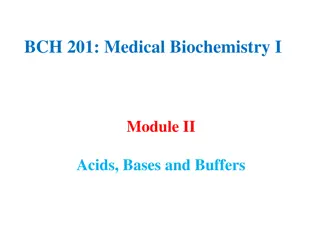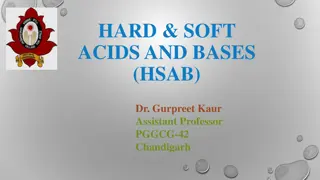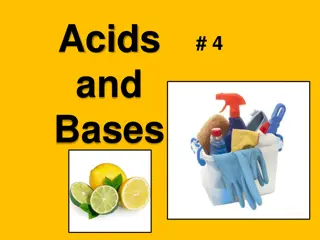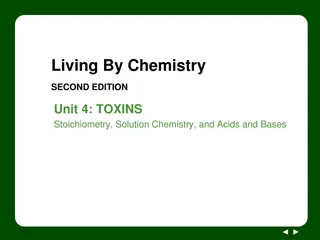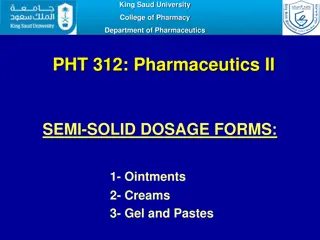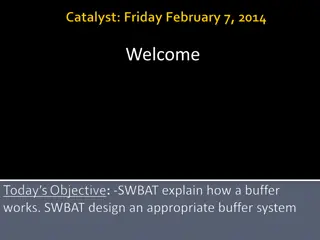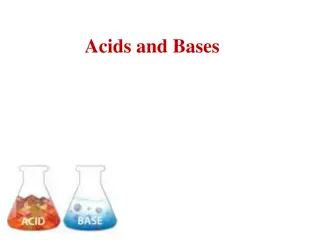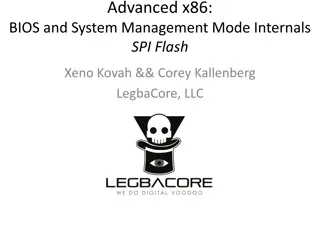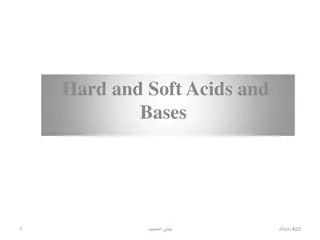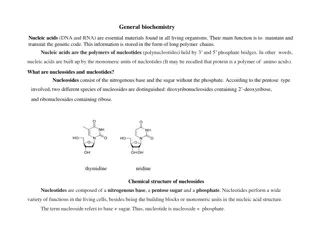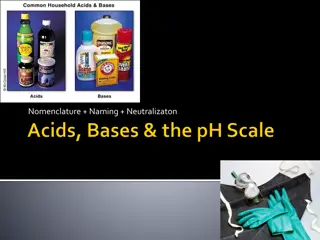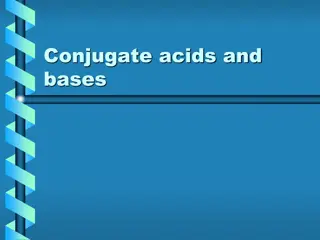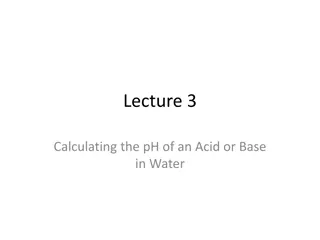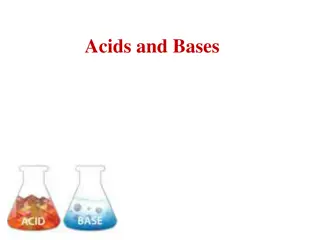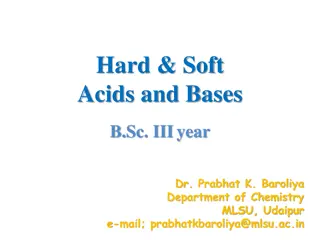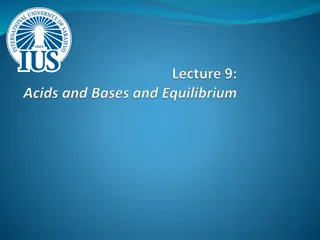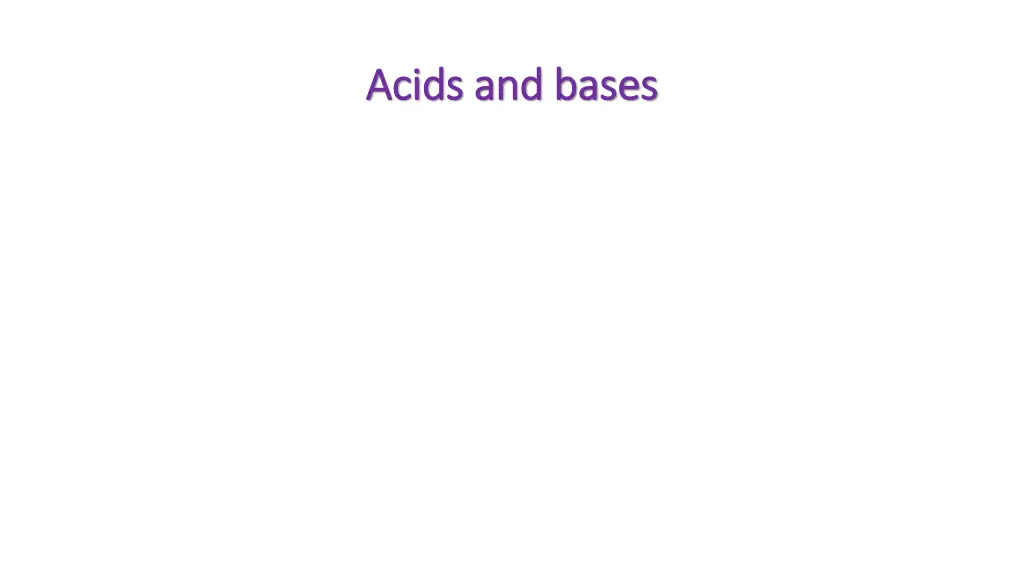
Understanding Acids and Bases in Chemistry
Explore the world of acids and bases, their properties, pH scale, types of bases, strong and weak acids, neutralization reactions with examples, and more. Enhance your knowledge of chemistry with this comprehensive guide.
Download Presentation

Please find below an Image/Link to download the presentation.
The content on the website is provided AS IS for your information and personal use only. It may not be sold, licensed, or shared on other websites without obtaining consent from the author. If you encounter any issues during the download, it is possible that the publisher has removed the file from their server.
You are allowed to download the files provided on this website for personal or commercial use, subject to the condition that they are used lawfully. All files are the property of their respective owners.
The content on the website is provided AS IS for your information and personal use only. It may not be sold, licensed, or shared on other websites without obtaining consent from the author.
E N D
Presentation Transcript
Acids and bases Acids and bases
Acids Acids Bases Bases In the lab: Hydrochloric acid, HCl Sulfuric acid, H2SO4 Nitric acid, HNO3 In the lab: Sodium hydroxide, NaOH Calcium carbonate, CaCO3 Copper oxide, CuO Household: Vinegar Lemon juice Hair conditioner Household: Bleach Indigestion tablet Soap
pH scale pH scale We use indicators to identify an acid or a base. Acids have a pH from 0 to below 7 Bases have a pH from above 7 to 14 Different indicators give different colours when added to an acid or a base.
Bases Bases All acids release H+ (hydrogen ions). A base is the chemical opposite of an acid. 3 types of bases: Metal hydroxide Metal oxide Metal carbonate If the base can dissolve in water, it s described as an alkali. All alkalis are bases, not all bases are alkalis.
HT Strong and weak acids Strong and weak acids All acids release H+ (hydrogen ions). Strong acids ionise completely. Weak acids ionise partially. Example: HCl H+ + Cl- CH3COOH CH3COO- + H+
Neutralisation reactions (chloride) Neutralisation reactions (chloride) Hydrochloric acid + sodium hydroxide sodium chloride + water HCl + NaOH NaCl + H2O Hydrochloric acid + copper oxide copper chloride + water HCl + CuO CuCl2 + H2O Hydrochloric acid + calcium carbonate calcium chloride + water + carbon dioxide HCl + CaCO3 CaCl2 + H2O + CO2
Neutralisation reactions (sulfate) Neutralisation reactions (sulfate) Sulfuric acid + sodium hydroxide sodium sulfate + water H2SO4 + NaOH Na2SO4 + H2O Sulfuric acid + copper oxide copper sulfate + water H2SO4 + CuO CuSO4 + H2O Sulfuric acid + calcium carbonate calcium sulfate + water + carbon dioxide H2SO4 + CaCO3 CaSO4 + H2O + CO2
Neutralisation reactions (nitrate) Neutralisation reactions (nitrate) Nitric acid + sodium hydroxide sodium nitrate + water HNO3 + NaOH NaNO3 + H2O Nitric acid + copper oxide copper nitrate + water HNO3 + CuO Cu(NO3)2 + H2O Nitric acid + calcium carbonate calcium nitrate + water + carbon dioxide HNO3 + CaCO3 Ca(NO3)2 + H2O + CO2
Required practical: making salts Required practical: making salts Outline Glossary Summary of method and context Exam question example Visual aid 1 Making salts Neutralisation: A chemical reaction of an acid with a base in which a salt and water are formed. If the base is a carbonate or hydrogen carbonate, carbon dioxide is also produced. Filtration: A technique used to separate an insoluble substance in a solvent. Evaporation: A technique used to separate a soluble substance in a solvent. It involves the solvent s physical change from a liquid phase to a gas phase. Crystallisation: A technique which follows evaporation, in which a solid in a crystalline structure forms. 1. Heat the acid gently until it is almost boiling. 2. Use the spatula to add small amounts of the base. 3. Stop adding the base when some of it remains after stirring. The acid and the base react forming a salt and water. The base is added in excess to ensure all the acid reacts. 4. Filter the contents. 5. Any excess of the base remains as a residue. 6. Pour the contents into an evaporating basin. The filtrate is an aqueous solution of the salt. 7. Evaporate this gently using a water bath on the tripod and gauze (see diagram). Stop heating once crystals start to form. 8. Transfer the remaining solution to a crystallising dish. Leave this in a cool place for at least 24 hours. Outline a safe plan the student could use to make pure, dry, crystals of the soluble salt copper sulfate from the insoluble metal oxide and dilute acid. Preparation of a pure, dry sample of a soluble salt from an insoluble oxide or carbonate, using a Bunsen burner to heat dilute acid and a water bath or electric heater to evaporate the solution.

